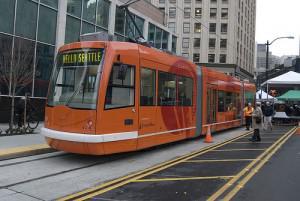 Despite the recent economic downturn, communities continue to grow and change. Local governments are having to think even more strategically about how to invest limited resources to get the biggest bang for the buck, quantitatively and qualitatively. Communities as disparate as Lansing, MI and Arlington, VA (and DC) are investing in public transit as a way to spur economic development, create better places, and grow transit ridership. But why does a streetcar make sense for one community while bus rapid transit (BRT) make sense for another?
Despite the recent economic downturn, communities continue to grow and change. Local governments are having to think even more strategically about how to invest limited resources to get the biggest bang for the buck, quantitatively and qualitatively. Communities as disparate as Lansing, MI and Arlington, VA (and DC) are investing in public transit as a way to spur economic development, create better places, and grow transit ridership. But why does a streetcar make sense for one community while bus rapid transit (BRT) make sense for another?
Streetcars are electric vehicles that operate in mixed traffic with rails embedded in the street and usually a single overhead wire. They carry more passengers than buses and often have floors level with the street, enabling easier access. BRT is a catch-all term encompassing improvements to bus infrastructure, scheduling, and vehicles.
The first question for a community is cost. Even though a streetcar has significantly lower capital costs than a subway system, it is still a larger investment than a BRT system, sometimes costing twice as much. For example, Arlington’s Columbia Pike streetcar’s capital costs are around $51M/mile while Lansing’s Michigan/Grand River BRT is around $24M/mile (based on estimates found on their websites). However, streetcar systems bring with them benefits that BRT systems cannot leverage. Streetcars carry more passengers, more quickly, and they attract more “choice riders” and tourists, people who typically don’t feel comfortable riding a bus. Also, streetcars signal to the private sector that that corridor is important to the community; the predictability of transit service can bring increased economic development, thereby increasing local tax revenue, and garnering various community benefits. An commensurate increase in density can create places that enable people to drive less and walk, bike and ride transit more often.
While the low cost of BRT is a major strength, the lack of infrastructure permanence makes the effectiveness of the system subject to political whims. For example, if a new BRT system is given its own dedicated lane of travel when it first opens, this lane could later be taken away, significantly slowing down the service, reducing its attractiveness and ridership. Thankfully, there is an emerging consensus about what a good BRT system looks like. Similar to the growing market consensus around what makes a building green (e.g. LEED), the BRT Standard could markedly increase the long-term effectiveness of BRT systems.
A community’s decision about which type of transit investment makes the most sense is difficult and often contentious. By agreeing on the vision for a corridor, determining the community’s financial/budgetary capacity, and weighing the costs and benefits of each approach, a community can begin to coalesce around a decision and focus on the details and dirty work that make these complex systems work for a community.
Image Source

